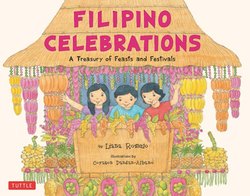Читать книгу Filipino Celebrations - Liana Romulo - Страница 6
На сайте Литреса книга снята с продажи.
ОглавлениеAnyone who knows something about the Philippines can tell you that Filipinos love a good party, and that we celebrate many different kinds of occasions—harvest time, a baby’s first birthday, the incoming new year, historical events, and so on. Even the most solemn Roman Catholic holidays, like All Souls’ Day, are more like celebrations than formal rituals.
foreign influences
A lot of foreign influences impact our celebrations: We adopted many of Spain’s traditions and practices; most significant of all, Christianity. We follow some American practices, too, as well as many Chinese traditions. Perhaps our most cherished holiday of all is Christmas. A great many Filipinos, no matter where they live in the world, come home to be with their families for the season.
other important celebrations
Most other Philippine celebrations are also Christian, including Easter and barrio festivals honoring saints. Although barrio fiestas are further evidence of Spain’s influence, these gatherings also showcase—at its best—Filipino hospitality and community spirit. At fiesta time, guests (even tourists) are welcome to wander into any house in the barrio, where the hosts will feed and entertain them.
historical influences
Before the Spanish came, Arab missionaries had already introduced Islam to certain parts of the country, and a few hundred Chinese merchants and traders lived on the Islands. Today, some Filipinos (mostly in the south) observe Muslim festivals, such as the Prophet Mohammed’s birth celebration.
Since early times, indigenous tribal Filipinos celebrated special occasions, like a baby’s birth or getting married. A shaman presided over the preparation of the thanksgiving gifts to be offered to the gods. Old tribal customs continued even after the Spanish arrived, but Catholic saints replaced native gods. If you wanted to become pregnant, for example, you prayed to Santa Clara instead of the native god of fertility. For healing the sick, Filipinos prayed to San Roque; and the rice god Lacanbaco became San Isidro Labrador.
When the Americans came to rule in 1901, they introduced their own festivals and celebrations. The Americans brought us beauty contests, like the Manila Carnival; they also taught us to sing the Happy Birthday Song and helped us create non-religious holidays, like Independence Day and Rizal Day.
There are a great variety of festivals in the Philippines, therefore—a mix of local and foreign flavors, sights, and sounds. Though it can be hard to understand the complex layers of some celebrations, and even a local might not be able to explain it to you, any occasion you go to will almost certainly involve music, laughter, games, and a whole lot of feasting.
